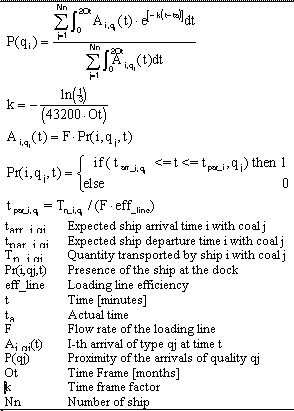The input variables relative to the yard quantities are defined through a combination based on fuzzy rules of quantities present in the different yards.
Each quantity is broken down into membership grades corresponding to three levels (small quantity, medium quantity, large quantity).
Their combination is based on a table created to consider that the coal stored in different yards cannot be immediately and easily accessed, since the corresponding conveyor lines come together and branch off from the same derivation towers.
This means that when operating with one yard, the second one will become available only if the other one is not already performing a complementary operation.
For example, if yard 1 is loaded with coal from an ocean-going ship, normally yard two is unloaded from a smaller coasting ship, since the available space for storing the coal is reduced and it is necessary to wait until the second operation has been completed to continue to unload the ship.
The variable that measures the amount of the incoming material is also strictly related to the available space, while the amount of the materials picked up corresponds to the quantity of material already stored.
Reference is made to the time/quantity index of the arrivals, integrating the next arrivals multiplied by an exponential observation window. In this way the closest deliveries will have the greater weight.
The following relationship is used:

This term must then be filtered based on the size of the arrivals expected in the near future (with reference to the time frame used, in this case two months), the size of the closest arrival and its relative time distance.
The material delivery procedure is similar to the one used for material acquistion.
Therefore, the decision support system proposes a set of information to the manager, based on suggestions supplied by the neural model, processed on the basis of all the other operating conditions.
Starting from the measurement of the opportunity to call a new ocean-going ship (to purchase an additional amount of coal), the availability is evaluated of a ship with those characteristics in a nearby area. If there is more than one possible alternative, a decision is made about which one to call. This occurs by ordering the available ships based on a fuzzy index that measures the correctness of each ship in relation to all the relative parameters foreseen at the possible arrival time:
Compliance with delivery constraints for that type of coal.
Dimension of the slot in which dock is available.
Ship capacity.
Quantity requested.
The same procedure is used for the small coasting ships which instead carry out orders of materials deriving from power stations.
The unloading procedure is based on the line operating conditions, and deviates from the reference percentages in relation to the preference suggested by the ANN (variation in transhipment quantity). The procedure to choose which of the two yards to place the greatest amount of the material is carried out in a similar manner. If it is possible to choose (or if both lines are available), reference is made to:
residual available spaces after possible filling
total available spaces
quantities to be stored
relative preference
Again, in this case, fuzzy logic is used to obtain a preference term.


